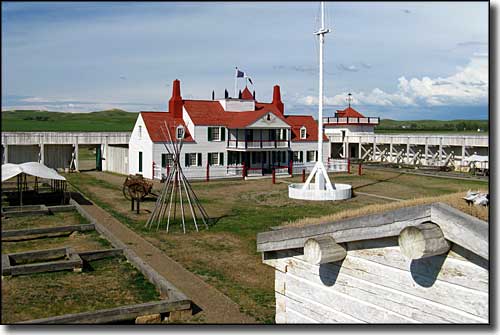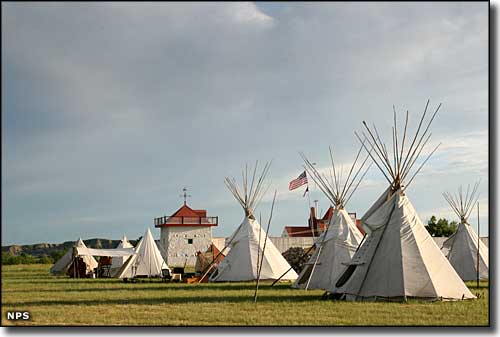Fort Union Trading Post National Historic Site

The courtyard of Fort Union Trading Post National Historic Site
Fort Union started in 1828 as a trading post built by the American Fur Company on the Upper Missouri River. For forty years, seven Northern Plains tribes traded buffalo robes and other furs for blankets, cloth, guns, beads and other manufactured goods. Business at the trading post averaged 25,000 buffalo robes and $100,000 worth of merchandise per year.
The fort was built in Assiniboine territory, at the request of the tribe. For nearly its entire working life, business at the fort centered around the Assiniboine. The Assiniboine are related to the Sioux, perhaps as a splinter group of Yankton Sioux who separated from the main tribe sometime in the 1600's.
The second most common tribe found at the trading post were the Crows. The Crows lived mostly up the Yellowstone River and the south bank of the Missouri was considered to be their northern territorial border. When the Crows arrived, their buffalo robes were in high demand because Crow women were widely regarded as the best tanners of prime winter buffalo cow hides. The Crows were close allies of the Hidatsa, culturally and linguistically similar to them.
The third prominent tribe was the Blackfeet, who were actually composed of three allied and related tribes (the Blood, the Blackfoot and the Piegan). In the early days of the fur trade, the Blackfeet would only trade with representatives of the British Hudson's Bay Company. For many years they had a nasty habit of killing American traders and trappers who entered their territory, then a trapper who'd lived among the Blackfeet in his early years convinced them to go to Fort Union and trade there. Eventually, the American Fur Company built forts further up the river at Fort McKenzie, then Fort Benton, and got closer to the Blackfeet homeland.
The Plains Cree were a people that migrated westward in the 1700's, following in the footsteps of British and French trappers and escaping the growing population pressures in the eastern forests where the original Cree lived. As they emerged on the Plains, they adopted the general Plains culture and began living in tipis and hunting bison. The Plains Cree were closely allied with the Plains Chippewa and both were close allies of the Assiniboine.
The Plains Chippewa were also known as the Ojibwa and, as the Ojibwa, had long controlled most of the land area around the Great Lakes. But they, too, had migrated westward in the 1700's to escape the building population pressures and adopted the Plains culture and way of life.
The Mandan arrived in the area in the 1400's or 1500's. They were different in that they lived mostly in earthlodges in semi-permanent villages and towns along the Missouri River. They only used hide tipis when traveling or when on hunting expeditions. Many of the tribespeople were farmers, growing large gardens of squash, beans, corn and tobacco. Fur traders met the Mandan early on in that business and by the time Lewis and Clark arrived in the area, they were quite hospitable. The Corps of Discovery built a winter fort near the Mandan villages and named it Fort Mandan in their honor.
The Hidatsa entered the area after the Mandans but before the fur trade really got off the ground. They were closely allied with the Mandans but weren't as friendly to outsiders. It was in the Hidatsa village Awahtixa that Lewis and Clark met Toussaint Charboneau and his wife Sacajawea...
The Mandans and Hidatsa were often at Fort Union in the early days but eventually, the American Fur Company built Fort Clark, then Fort Berthold closer to their settlements. There was a time in the 1870's when a band of Hidatsa occupied the decommissioned Fort Union, seeking to escape inter-tribal politics, reservation life and on-going wars with the Lakota (their long-time enemies). They erected a village in the old Fort Union garden but returned to the vicinity of Fort Berthold in the late 1880's.
The Arikara were very similar to the Mandans and Hidatsas but were related to the Pawnee tribes further west and south. The Arikara lived in villages along the Missouri, too, until a confrontation with an American trapping group led to an attack by the US Army 6th Infantry and they were pushed out of their villages for several years. They returned just in time to enjoy the wonders of the 1837 smallpox epidemic, an event that almost wiped out the Arikaras, Mandans and Hidatsas. By 1862, all three tribes had moved in together for protection from the Lakota Sioux. Today, the three tribes are known as the Three Affiliated Tribes.
Probably the largest tribe in the area were the Sioux, a common name for three large tribes that shared a common culture and language. The tribes were differentiated only by small differences in their dialect... and each tribe was essentially named for their dialect: the Dakota, Nakota and Lakota. The Dakotas lived originally in Minnesota but were forced further west following the Minnesota Uprising War in 1862. The Nakota (Yankton and Yanktonai) lived in eastern South Dakota and central North Dakota. The largest Sioux tribal group were the Lakotas, a group made up of seven distinct bands who occupied the countryside between the Missouri River and the Bighorn Mountains, between the Platte River and the Canadian border. The Lakota didn't really make an appearance at Fort Union until the 1840's and didn't appear in large numbers until the late 1850's. By the time Fort Union was closed in 1867, the Lakota had pretty much taken the area from the Assiniboine.
During the forty-year lifetime of Fort Union, the fort was a beacon of peaceful, beneficial and prosperous co-existence. Historical visitors to Fort Union include George Catlin, John James Audubon, Sitting Bull, Jim Bridger, Karl Bodmer and Father Pierre DeSmet. The site was one of the first designated National Historic Landmarks in 1961 and the fort we see today is a partial reconstruction of the original edifice. The property straddles the Montana-North Dakota state line.

A modern re-enactment of a rendezvous at Fort Union Trading Post
Other photos courtesy of the National Park Service